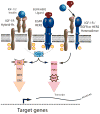The insulin-like growth factor system in cancer
- PMID: 22682634
- PMCID: PMC3614012
- DOI: 10.1016/j.ecl.2012.04.014
The insulin-like growth factor system in cancer
Abstract
Insulin-like growth factor (IGF) plays an important role in tissue growth and development. Several studies have demonstrated the association between circulating levels of IGF-1 and -2 and cancer risk, and the IGF system has been implicated in the oncogenesis of essentially all solid and hematologic malignancies. The optimal strategy for targeting IGF signaling in patients with cancer is not clear. The modest benefits reported thus far underscore the need for a better understanding of IGF signaling, which would enable clinicians to identify the subset of patients with the greatest likelihood of attaining benefit from this targeted approach.
Copyright © 2012 Elsevier Inc. All rights reserved.
Conflict of interest statement
P.H. receives research funds from BMS, Roche, ImClone, GSK, Pfizer, Merck and MedImmune and is an unpaid consultant for BMS, Roche, Merck and MedImmune.
Figures


References
-
- Baris D, et al. Acromegaly and cancer risk: a cohort study in Sweden and Denmark. Cancer Causes Control. 2002;13(5):395–400. - PubMed
-
- Kauppinen-Makelin R, et al. Increased cancer incidence in acromegaly--a nationwide survey. Clin Endocrinol (Oxf) 2010;72(2):278–9. - PubMed
-
- Orme SM, et al. Mortality and cancer incidence in acromegaly: a retrospective cohort study. United Kingdom Acromegaly Study Group. J Clin Endocrinol Metab. 1998;83(8):2730–4. - PubMed
-
- Ron E, et al. Acromegaly and gastrointestinal cancer. Cancer. 1991;68(8):1673–7. - PubMed
-
- Jenkins PJ, et al. Insulin-like growth factor I and the development of colorectal neoplasia in acromegaly. J Clin Endocrinol Metab. 2000;85(9):3218–21. - PubMed
Publication types
MeSH terms
Substances
Grants and funding
LinkOut - more resources
Full Text Sources
Other Literature Sources
Miscellaneous

